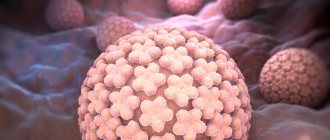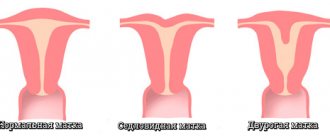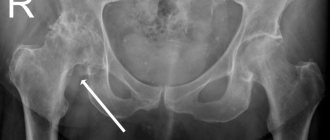general information
Condylomas are a benign tumor formation that is “located” on the epidermis or mucous tissues and looks like warts and papillae. Single specimens (about 7 mm) or entire “colonial formations” (up to several tens of mm) of condylomas settle on the body of women and men and often resemble cauliflower in appearance. The color of these substances ranges from flesh-colored to brown. Condylomas are viral in nature, so such problems can even occur in children (during childbirth from an infected mother). As long as the growth has not reached the epidermis, the person does not pose a threat to others; the risk of infection increases if the growths are located in the epidermal layer. Condylomas are usually divided into two types:
- wide;
- pointed.
In the first case, condylomas in women and men look like a mushroom with a cap and a wide stalk and are most often a consequence of secondary stage syphilis. Condylomas of the genital type are transmitted through sexual relations; the human papillomavirus (HPV), which is activated under certain conditions, is involved in their appearance. The main location of genital warts is the genitals and oral cavity. Condylomas in women settle on the outer and inner parts of the labia, in the vagina, clitoris and anus. Warts and papillary growths in men select the glans penis and frenulum of the foreskin.
Clinical manifestations of PVI
The most common clinical manifestation of PVI is genital warts (anogenital warts - AB) (in 90% of cases caused by HPV types 6 and 11). The peak incidence occurs between the ages of 18 and 28 years and does not depend on gender. Genital warts are benign formations caused by various types of HPV. More than 90% of patients with genital warts are infected with HPV genotypes 6 and 11. Infection with the highly oncogenic HPV types 16 and 18 most often causes subclinical lesions associated with intraepithelial neoplasia and cancer of the vulva, vagina or rectum [10, 12]. Over the past decade, the incidence of genital warts has increased sharply and today accounts for about 2% of sexually active people, and when assessed using PCR, the number of people infected with HPV is much higher [14, 15]. The high frequency of PVI and the high risk of developing associated diseases require effective methods of therapy. Medicine is on the verge of global change; the rather conservative health care system, focused on the treatment of diseases, is being restructured and focuses on protecting individual health [15]. The problem of strictly following the doctor's orders is as old as medicine itself. A number of patients voluntarily replace prescribed medications with others, based on their own ideas about the harm or benefit of such drugs for health. Collaboration with a doctor (compliance) is a highly individual phenomenon, and deciding whether to follow a doctor's orders or not usually takes time. The patient must weigh the pros and cons according to his lifestyle and health beliefs. Not only the communication skills of the doctor and the trusting relationship with the patient have a significant impact on compliance and treatment results, but also the dosage form, availability of the drug, dosage regimen and a number of other factors. Personalized medicine involves tailoring therapeutic treatments to each patient's individual characteristics to identify subpopulations that differ in their susceptibility to a particular disease or their response to a particular treatment. At the same time, based on genomic data, the likelihood of the occurrence of a particular disease is predicted and preventive individual treatment regimens are developed [15].
Reasons for appearance
“What causes condylomas?” - a question that worries patients with a similar problem. The route of infection with condylomas is through unprotected sexual contact. Moreover, these include traditional intimate relationships, as well as oral, anal and homosexual relationships. Children get the disease from sick women while moving through the birth canal. Do not be negligent about household methods of infection. There is no need to take risks and use other people’s personal belongings, especially bath accessories (washcloth, towel, flip flops, etc.). Condylomas are activated under the influence of certain factors:
- indiscriminate unprotected sex;
- early onset of intimate relationships;
- sexual contacts with partners with condylomas or HPV carriers;
- decreased immune abilities of the body;
- previous diseases of the genital tract;
- frequent stress, vitamin deficiency;
- sloppiness and failure to comply with personal hygiene rules.
The appearance of genital warts is often associated with HPV. Human papillomavirus infection poses a great danger for the development of cancer. Condylomas of this etiology are the object of study and treatment by doctors of different specializations: in women - by gynecologists, in men - by urologists. If the location of condylomas is in the anal area, then a proctologist leads the patients. You should definitely consult about genital warts, because the development of the disease can occur in a variety of ways - from self-healing to the degeneration of condylomas into malignant formations. The specialists of the Global Clinic Center have accumulated positive experience in solving such problems, so contacting the clinic is a prerequisite for successful treatment of the patient.
Treatment methods for PVI
Cryotherapy, laser vaporization, electrocoagulation, and surgical excision used to treat genital warts are painful, expensive, and do not protect against recurrence. More conservative methods of therapy include the use of podophyllin, dichloroacetic and trichloroacetic acid. These drugs must be applied more than once in a clinical setting; in addition, when they are used, local inflammatory reactions often occur: erythema, erosion, and even ulcerative defects. None of these methods provides comfortable removal of condylomas with long-term effect and low recurrence rates [16, 17]. Local destruction of foci with clinical and subclinical manifestations of PVI allows one to act only on the area of the epithelium where the clinical manifestation of the infection occurred, while the HPV reservoir remains in the surrounding tissues in a latent state or in an undiagnosed subclinical form [18]. The inclusion of interferon-alpha in the treatment of PVI made it possible to hope for the emergence of a method that would eliminate not only the clinical manifestation, but also the virus itself by activating the immune system or having a specific antiviral effect. However, the use of this remedy requires multiple injections, and although it leads to the elimination of condylomas in 36–62% without destroying the underlying layers of the skin, it is also accompanied by a high percentage of relapses [19, 20]. In addition, it is an expensive therapy that is accompanied by systemic adverse effects and requires a large number of clinic visits. Interferon-alpha is poorly absorbed, so local treatment is ineffective. The use of interferons or podophyllin is not recommended due to their low effectiveness and toxicity [12–16]. In recent decades, a whole generation of immunomodulators has appeared in Russia, i.e. drugs that can have a regulatory effect on the immune system. Some of them have shown high efficiency in the treatment of a wide variety of pathologies [17]. For example, it has been found that patients with urogenital infections have an imbalance in the cytokine profile, which is manifested in an increase in the level of Th-2 class cytokines (interleukin 6) and a decrease in the content of Th-1 class cytokines (interferon-γ) [22]. In compensating for these disorders, the drug inosine pranobex turned out to be one of the most effective and safe. A multicenter, prospective, randomized, placebo-controlled study showed that in 55 patients of both sexes with a one-year history of refractory AB, a four-week course of inosine pranobex 3 g per day improved the clinical response to conventional treatment (podophyllin or trichloroacetic acid). Significant improvement compared to placebo was noted in 82% of patients (the number of condylomas and the degree of lesions decreased), and in 36% there was complete elimination of HPV [18]. A group of 165 men and women with genital warts were treated with inosine pranobex, or conventional treatment (podophyllin + cryotherapy), or both. Inosine pranobex (1 g 3 times a day for 4 weeks) was more effective for long-term lesions (average duration 40 weeks), whereas conventional treatment was effective for shorter disease duration (12 weeks). Overall, the addition of conventional treatment with inosine pranobex increased the success rate of therapy from 41 to 94% [19]. A randomized, placebo-controlled study of the efficacy and safety of inosine pranobex (50 mg/kg daily for 12 weeks) in the treatment of genital warts resistant to conventional therapy was conducted in Greece. Women (38) aged 20–43 years received the drug (50 mg/kg daily for 12 weeks) or placebo. Complete recovery was noted in 24%, while significant improvement was observed in 65%; the therapeutic difference between women taking the active substance and placebo was statistically significant (χ2=6.69, P<0.01). There were no relapses during the 12-month follow-up. Moderate side effects were noted that disappeared after completion of therapy [20]. A review of 59 sources of domestic and foreign literature devoted to the use of the immunomodulator Isoprinosine in the treatment of patients infected with HPV, as well as the results of our own experience showed the high prevalence of HPV, its role in the development of cervical cancer, the mechanisms of development of PVI and the protection of the host body from it. Among medicinal methods of influence, a special place is occupied by inosine pranobex, which is an immunomodulator with antiviral activity: it suppresses the replication of DNA and RNA viruses by binding to the cell ribosome and changing its stereochemical structure. HPV infection, especially in the early stages, can be successfully cured, up to the complete elimination of the virus. Inosine pranobex has a dual effect and has the largest evidence base [20–24]. Complex treatment of PVI - genital warts in men 20–30 years old using the immunomodulatory drug Isoprinosine showed effectiveness in the long term: disease recurrence after 8 months. in the group of patients who underwent only destructive methods of treatment, it was diagnosed in 32% of cases, in the group of combination therapy (destruction + Isoprinosine) - in 7%. The spectrum of pharmacological action of the drug (immunostimulating, antiviral), the effectiveness of combination with destructive methods of treatment make it possible to consider the inclusion of inosine pranobex in the complex therapy of genital warts, including for the purpose of preventing relapses of this disease [24]. Combination therapy, including destruction and inosine pranobex, is the international standard for the treatment of genital warts. According to the European Policy on HPV-Associated Diseases, the use of interferons, 5-fluorouracil or podophyllin is not recommended in the general practitioner's office due to their low effectiveness and toxicity. The use of systemic immunomodulatory agents may be recommended for recurrent disease, in cases of localization of the process in the intravaginal, cervical, intraanal and intraurethral areas and for HPV of high oncogenic risk (type 16, 18). In addition, HPV is insensitive to antiviral drugs that are used for other viral infections, since HPV DNA encodes a small number of enzymes and does not have polymerases, kinases or proteases, which are targets for existing antiviral drugs [17, 24–28]. The use of inosine pranobex in combination with radio wave methods for the treatment of cervical diseases associated with HPV increases the effectiveness of therapy to 93.5%. The results of a clinical study conducted by P.V. Budanov et al. demonstrated that the use of inosine pranobex helps to stop the release of HPV from the lesion and normalize the morphological picture of the exo- and endocervix, increases the effectiveness of destructive treatment methods, and also reduces the frequency of relapses. Such characteristics make it possible to conclude that inosine pranobex is highly effective in the treatment of HPV infection in young women of reproductive age [29]. These results were confirmed by the works of other authors [30]. The duration of treatment for HPV with Isoprinosine, used in monotherapy for 14–28 days, 2 tablets 3 times a day, is critical, since it corresponds to the natural cycle of epithelial renewal and promotes the elimination of HPV. With a 28-day course of Isoprinosine, renewal of the epithelium and elimination of the virus occur under the guise of drug therapy, preventing its spread and further integration. With a 28-day course of treatment, elimination of the virus in 93.7% of patients was observed within 6 months. This approach demonstrates the need for active tactics in the management of patients with initial lesions of the cervical epithelium associated with HPV [31]. As is known, viral co-infections (especially HPV) are an inevitable accompaniment of HIV, which determines the medical and social significance of this problem [32]. Currently, Russia ranks 3rd (after South Africa and Nigeria) in terms of the rate of emergence of new cases of HIV infection per unit of time (in terms of growth rate). It is important to note that in Russia, among people aged 30–35 years, 2.5% of men and 1.2% of women are infected with HIV. Currently, the risk of sexually transmitted infection is significantly increasing. The risk of infection from an infected partner during unprotected sex is almost absolute. As a clear example of coinfections, we present a clinical observation.
Symptoms
The main manifestation of growths is their unpleasant and repulsive appearance. But women will also be reminded of condylomas by other unpleasant moments. The time elapsed from the first contact-infection to the moment when condylomas become clearly visible can be completely different. Sometimes a week or a month is enough for condylomas to appear; in other situations, years may pass. The incubation period depends on the general health of the woman or man, their immunity, lifestyle, etc. Condylomas in women and men cause itching and burning in the genital area and near the anus. This occurs during the period of germination of condylomas; in the future, such symptoms may disappear. An increase in the amount of whitish discharge, sometimes mixed with blood and an unpleasant odor, provokes condylomas in women, which are localized on the vaginal mucosa or cervix. When condylomas are found in the anus, the passage of feces can injure them and cause ichor.
Pathogenesis of genital warts
HPV is found in the cellular structures of the skin and mucous membranes, so it can be transmitted from men to women, from adults to children. The long latent period of infection makes early diagnosis of the disease difficult. Condylomas are not immediately visible to the naked eye. To activate HPV, a large number of these pathogens is necessary, only then the papillomavirus “comes out”, represented by genital warts. An increase in HPV may occur due to decreased immunity in women or men. Genital condylomas are caused by the process of atypical reproduction of the human papilloma virus; under its influence, epithelial cells grow and develop with pathology. The skin and mucous tissues change and this is how condylomas appear. Growths in the form of warts and papillae can be single or massive, turning into entire “conglomerates” of condylomas.
Diagnostics
Human papillomavirus infection (genital warts) is diagnosed in different ways, from visual examination of women and men to the most advanced examinations. CM "Global Clinic" has in its arsenal the latest techniques for determining the nature of condylomas. Diagnostic methods used by doctors:
- Clinical examination. Some types of diseases in women and men can be masked, taking the form of genital warts, so you need to have sufficient qualifications to differentiate different problems.
- Colposcopy is recommended for women, and urethroscopy for men.
- A smear will tell a lot about condylomas in women and their nature; this cytotest will also help to exclude cervical dysplasia.
- Histology.
- Diagnostics-PCR. This examination not only detects the presence of human papillomavirus, but also determines its type.
- Immunological research. It is used to detect antibodies to HPV in the blood.
All women and men affected by genital warts must be tested for infectious diseases of the genital area (syphilis, HIV, etc.)
Clinical observation
A 23-year-old man consulted a doctor with multiple tumor-like growths on the penis that appeared within 2–3 months. (Fig. 1 A). History of HIV infection (less than 1 year) after unprotected sexual contact with an unfamiliar woman. After discussing treatment options, combined treatment with Isoprinosine and surgical excision of tumor growths was chosen. Based on the results of histological examination, giant Buschke-Levenshtein condyloma (a type of genital condyloma, characterized by progressive growth and large size) was diagnosed. Before starting therapy, the patient was screened for STIs. Chlamydial infection was detected using the PCR method and etiotropic therapy (doxycycline monohydrate) was recommended. At the repeat visit, positive dynamics in the resolution of the process were noted (Fig. 1 B).
Treatment
Condylomas and HPV require a systematic approach to treatment.
Medication
To combat condylomas in women and men, doctors act in three directions:
- against viruses;
- in order to increase immunity;
- for fortification of the patient.
Cycloferon and inosiplex act against HPV activation and its reproduction. Inferon and allokin-alpha stop viruses and help restore the immune system. To improve the general health of women and men, Immunal, Amixin, Poludan, etc. are prescribed. A complex of vitamins and minerals is also an essential component of treatment for condylomas.
Local
Condylomas are successfully treated using ointments and sprays of antiviral action (epigen-intim, condylen, etc.). Women and men will not have to think about condylomas if they are treated with inquimod, podophyllotoxin. For pregnant women, you can use trichloroacetic and nitric acids. Women need to fight condylomas in stages: first remove them, and then, or in parallel, act to reduce the number of viruses. Often (in every third woman) condylomas enter the stage of relapse (especially if preventive measures are not followed and the recommendations of the attending physician are ignored).
Removal
Methods for removing condylomas in modern medicine are varied:
- Electric coagulation. This method has disadvantages - many contraindications, painful procedure and long recovery.
- Cryotherapy. Condylomas are removed using liquid nitrogen. The positive aspects of this technique are the absence of scars, painless effects, and the absence of anesthesia.
- Surgical method. The growths are removed during surgery, and stitches are placed at the site of the wounds. Doctors use local anesthesia.
- Use of chemicals. This method is contraindicated during pregnancy and lactation.
- Laser therapy. Condylomas are removed with a laser beam; this is a treatment that does not affect healthy cells and leaves virtually no scars.
- Radiosurgical method. The use of a special device helps remove condylomas without contact with the body. Removal of growths is accompanied by simultaneous sealing of blood vessels. This technique is one of the most modern and in demand.
Why do you need a cytology test for cervical papillomas?
Cytological examination by Papanicolaou test (PAP test) is the main method for identifying pathological changes in cells and diagnosing precancerous and cancerous pathologies of the uterine cervix.
Material for research is collected from the border of the transition of squamous epithelium to columnar epithelium.
Special brushes and spatulas are used to scrape off the cells, and the resulting cells are placed on a glass slide.
In the laboratory, the sample is stained with two preparations and changes in the cell nuclei and cytoplasm are assessed under a microscope.
The method allows you to determine the nature of the existing changes (inflammation, malignant transformation, reactive changes, etc.).
A specific marker of lesions caused by papillomavirus are koilocytes - cells with uneven large nuclei and vacuoles (normally there are no vacuoles).
Another sign of HPV is the appearance of dyskeratocytes - cells with altered cytoplasm and small dark nuclei.
If cellular changes are confirmed based on the results of the PAP test, a targeted biopsy is performed.
The resulting small pieces of tissue are sent for histological examination.
When cervical papillomas are detected, PCR typing of the virus is recommended in some cases.
This is a determination of the group membership of the pathogen in order to predict the risk of oncological changes.
PCR allows you to detect the virus even in extremely low concentrations.
That is why it is this method that is used to carry out control tests after recovery (including spontaneous).
A relatively new method for diagnosing HPV infection is the detection by ELISA of the E7 oncoprotein in material obtained from the cervical canal.
This protein is normally absent in tissues, and its appearance is due to the activity of HPV.
It is assumed that thanks to such a study it is possible to differentiate between simple carriage of the virus and the initial stages of the processes of tumor change in the affected cells.
Preventing HPV infection
Condylomas must be prevented by preventive measures:
- use of contraceptives during sexual relations;
- increasing immunity;
- proper balanced nutrition;
- taking vitamins;
- compliance with hygiene standards;
- fight against bad habits;
- increasing stress resistance.
Regular visits to the doctor are a good preventative measure. The use of antiviral ointments, as well as vaccination against HPV, is prevention that will make people’s lives full.
Pregnancy and condylomas
Condylomas are an alarming signal for pregnant women. HPV in the body of the expectant mother does not have a harmful effect on the fetus, but such a lady must be under the supervision of the attending physician at all times. You can resort to removing growths only at the 28th week of pregnancy, not earlier. If the formations have settled on the genitals, then there is a high probability that the baby will acquire HPV while passing through the birth canal. If the infection is not treated, then the unpleasant moments associated with thrush increase in pregnant women. The best option is a thorough examination before pregnancy for HPV and, if it is detected, mandatory and complete treatment.










